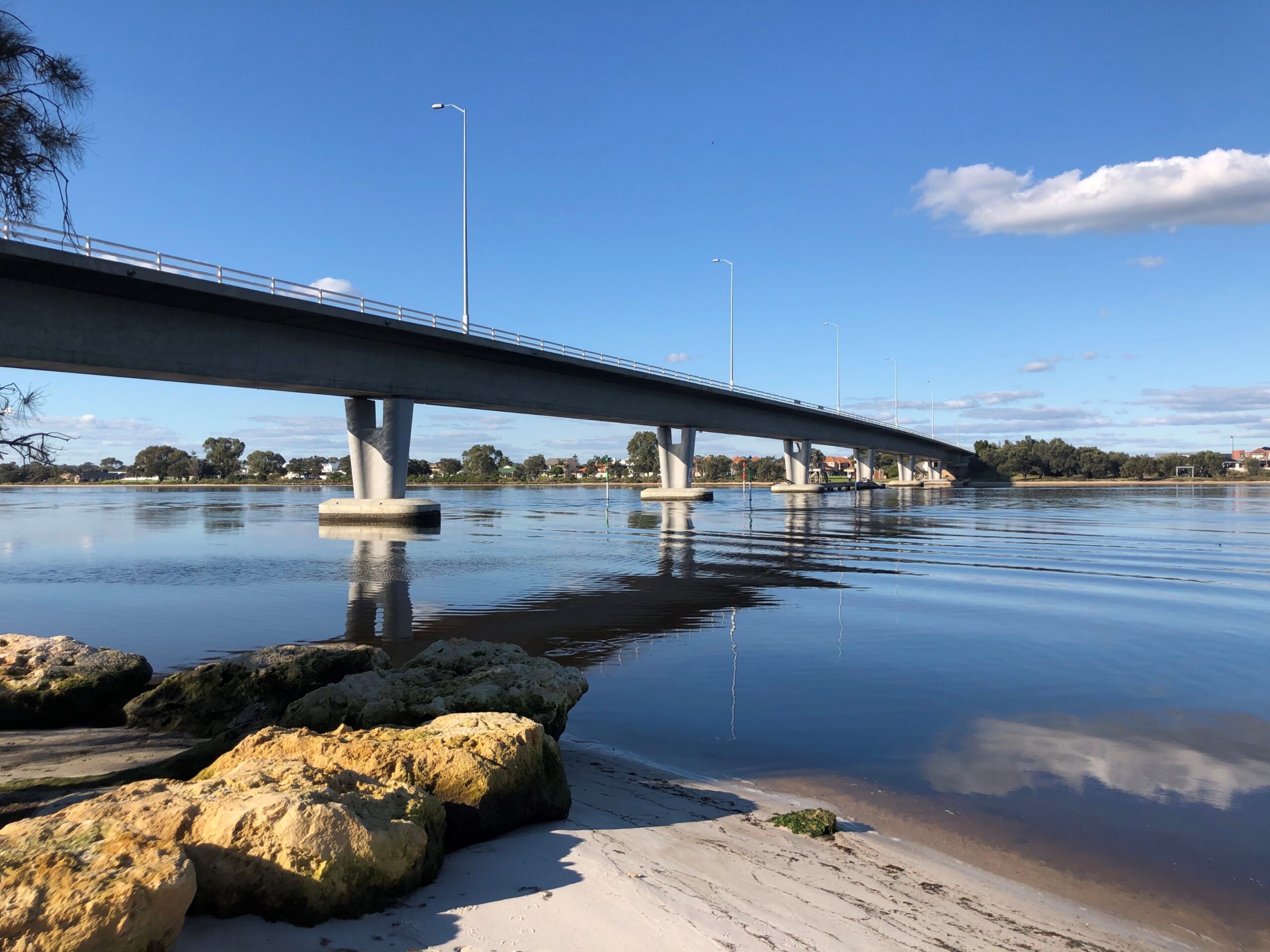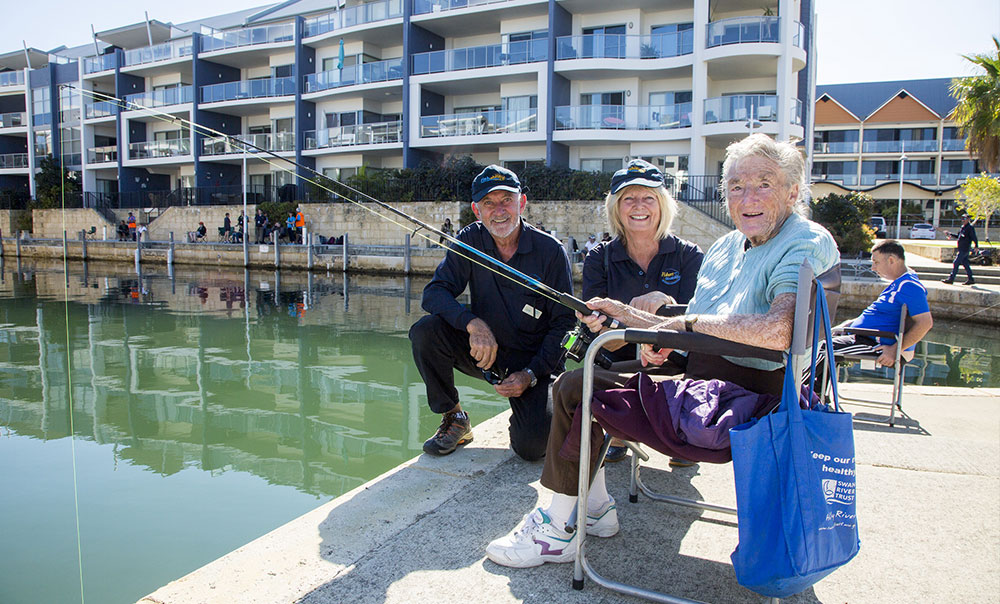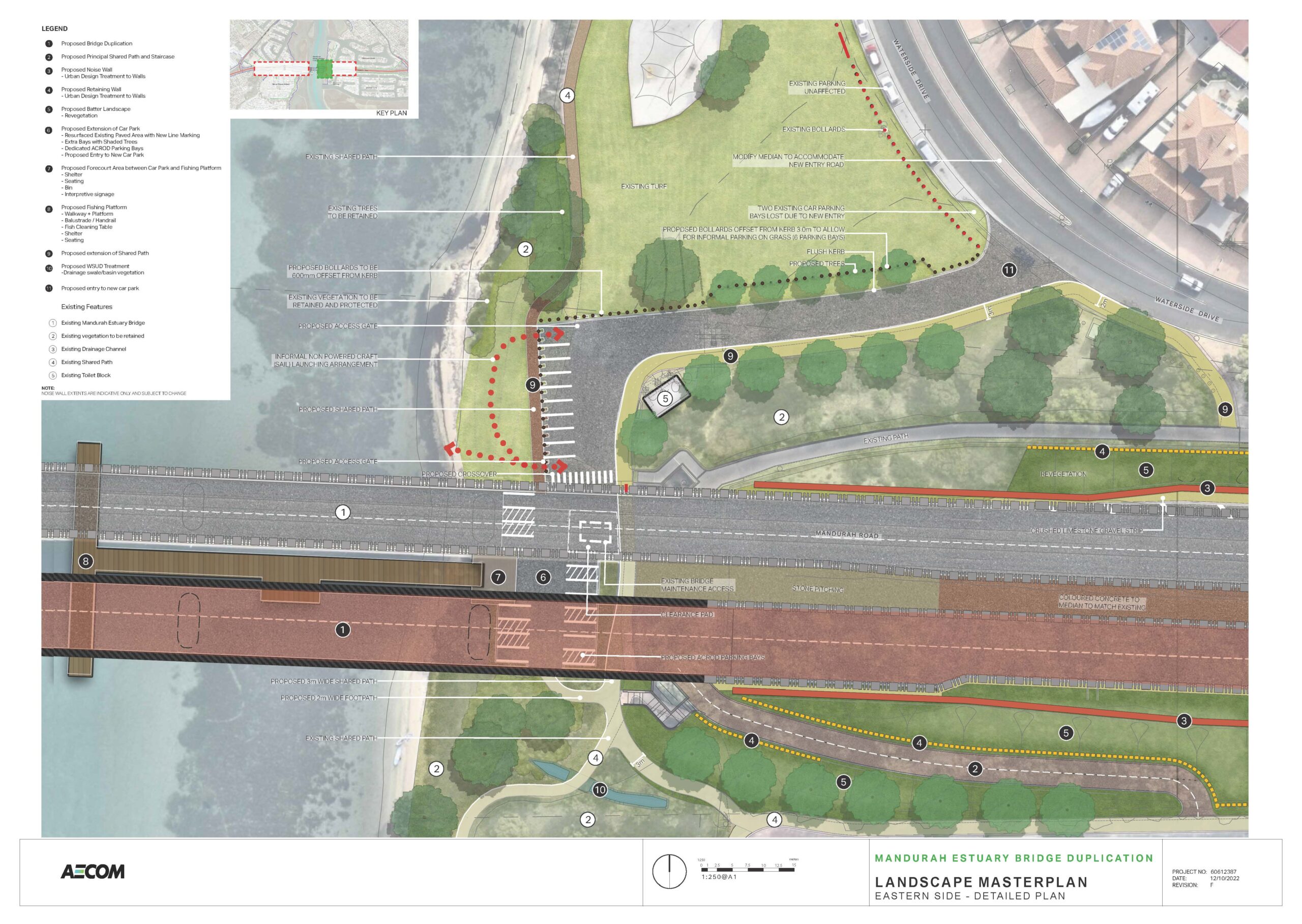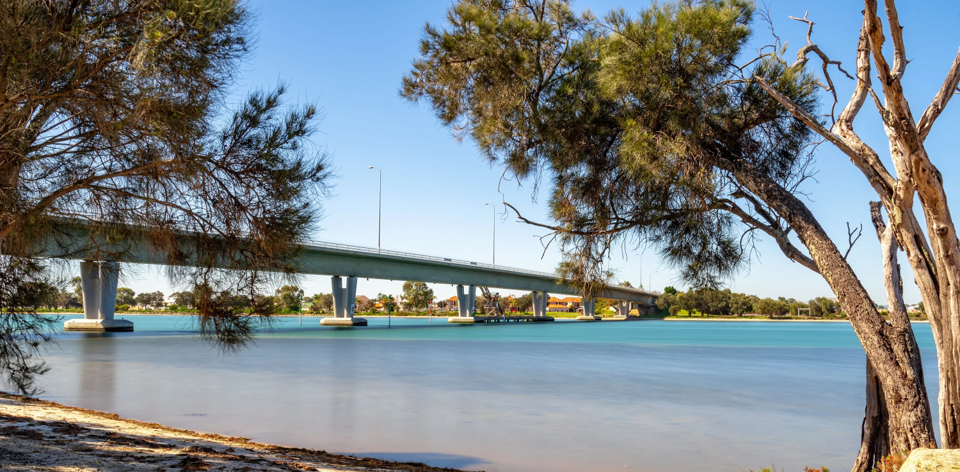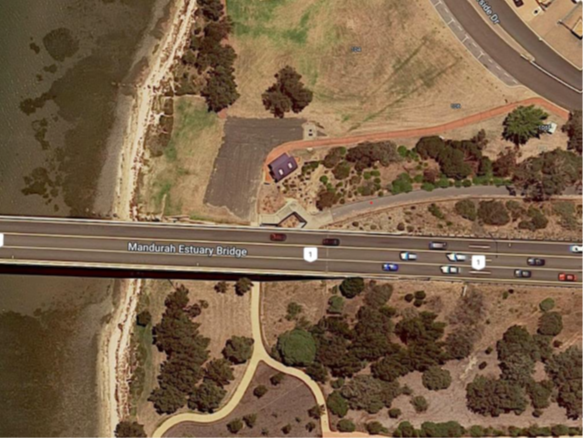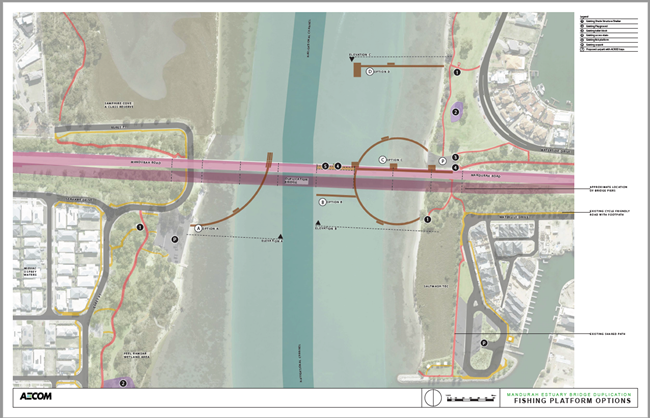Mandurah Estuary Bridge Duplication Project – Social Outcomes
Describe WHAT you have done and HOW you have done it.
Through collaboration with external stakeholders representing people with disabilities, Main Roads Western Australia (Main Roads) and AECOM have designed a universally accessible fishing platform, ACROD carpark and wide, level footpaths tailored to address community needs, heighten user experience and enhance recreational use of the Mandurah Estuary foreshore for a minority group who is often overlooked.
Main Roads is constructing the Mandurah Estuary Bridge Duplication project in the City of Mandurah, Western Australia. The scope of the project was to:
• Build a second bridge over the Mandurah Estuary, adjacent to an existing bridge, that delivers additional traffic capacity, and reduces congestion and crashes on the existing bridge;
• Improve access for walkers and cyclists, via a new shared path on the underside of the new bridge deck; and
• Provide a universally accessible recreational fishing platform.
As the concept design evolved during the Planning phase, it became clear that the provision of ACROD parking bays and path access to the foreshore were as important as the fishing platform. A shortage of fishing areas for people with disability or mobility impairments within the Mandurah region was identified, with fishing facilities increasingly overcrowded and limited in space. A key issue with some existing fishing areas was access to the site. Without carefully planned and appropriate parking and pathways, use of the new fishing platform would be restricted.
The fishing platform, carpark and footpath initiative were achieved through a cooperative approach to stakeholder engagement, led by the Main Roads Project Manager and Stakeholder Engagement Lead. As well as the usual communication channels of workshops, meetings and emails, the City of Mandurah Access and Inclusion Advisory Group (AIAG) and Fishability Mandurah had direct input into the location and design of facilities through site visits, open communication with the Project Manager and review of key design documents.
Four locations were initially investigated for the fishing platform. Following discussions with AIAG and Fishability Mandurah, three options were discarded:
• The option on the western foreshore was not considered viable due to limited parking and insufficient water depth for fishing.
• The option north of the bridge was unfavourable due to lack of shade, vegetation clearing requirements and insufficient carpark space.
• A circular platform under the bridge was not suitable because the shape would limit fishing space and cause fishing line entanglements.
The stakeholders’ preferred option was a platform under the bridges, as this would provide shelter and access to deep water.
The preferred location posed several accessibility obstacles. Vehicle access is currently limited to City of Mandurah maintenance vehicles, via a locked gate. The closest public parking is a small number of parallel bays on Waterside Drive, 100m from the foreshore. The foreshore is only accessible via a minor gravel footpath from Waterside Drive to a small ablutions block, with access to the beach via a grassy area. In its current layout, accessibility to the eastern foreshore is highly constrained for people with mobility difficulties, given the absence of suitable carparking facilities and footpaths.
What were the OUTCOMES and how were those outcomes shared?
The outcomes of the collaborative design approach with key user groups and accessibility advocates (including meetings, two workshops and two site visits) is a concept design that went beyond delivering a fishing platform by:
• including a new carpark with several dedicated ACROD parking bays, and
• providing improved pathways which not only provide access to the universally accessible fishing platform but also facilitate access to the existing ablutions block and pathways along the broader foreshore area.
The concept of installing ACROD parking bays was first raised with Main Roads by the City of Mandurah AIAG in May 2022. The AIAG noted that parking, possibly comprising a combination of street parking and parking close to the fishing platform, was crucial to facilitate access to the fishing platform. Any street parking would need additional space for people to safely exit their vehicles, as well as sufficient space for wheelchairs. Main Roads then liaised with Fishability Mandurah to understand the group’s needs with regards to estuary accessibility. Learnings from this event were applied to the proposed design of the new carpark; principally making carparking closer to the future fishing platform and providing an increased number of ACROD bays. Main Roads later met onsite with Fishability Mandurah to ensure the proposed fishing platform design would meet the needs and be fit for purpose for this key user group. Carparking was further discussed at this meeting, where it was noted that by Fishability Mandurah that 2-3 ACROD bays would be sufficient. Path connections were also discussed.
Due to the importance of sufficient and accessible carparking to enable larger events such as those hosted by Fishability Mandurah, Main Roads and AECOM included eight ACROD bays in the concept design. Further stakeholder feedback on the concept design was sought in August and September 2022. Feedback again highlighted the importance of the ACROD parking and provided feedback on the carpark design, specific configuration of the eight ACROD bays and drop off / pickup area. The path connectivity to the platform, carpark, ablutions block and foreshore were also discussed.
The outcomes achieved through the collaborative approach to stakeholder engagement include:
• A fishing platform location that was agreeable to key stakeholders and likely to increase use of the platform.
• Optimised fishing platform design, that incorporates platform sizing and shape, handrails and kerbing, decking material and seating that are tailored for people with mobility impairments.
• A carpark location that enhances ease of access to the fishing platform, foreshore and existing ablutions facilities.
• Carpark design comprising a combination of ACROD and normal bays, enhancing accessibility for both drivers and passengers with disability to get in and out of cars. A new six-bay informal grass car parking parallel to the new foreshore access road, and a formal carpark with eight ACROD bays beneath the new and existing bridges have been designed.
• New footpath connection from the new street accessway through to the foreshore and onto the fishing platform, with connectivity to the existing ablutions block. The path will facilitate access and increase user experience through new connections to the foreshore and wider path networks.
The Planning phase outcomes were shared as follows:
• Annual Public Sustainability Report. The first annual Public Sustainability Report reported on the initial stakeholder engagement process, including its influence on the location and design of the new universal access fishing platform, accessibility considerations and path connections.
• The Fishing Platform Basis of Design (MP Rogers 2022) details the story of the development of the concept design in collaboration with external stakeholders. This document was shared with the project team.
• The Urban and Landscape Design Framework (AECOM 2022): This was shared with the City of Mandurah AIAG and Fishability Mandurah, both of whom had multiple opportunities to review and have input into the document.
• Legacy Memo (Jacobs 2022): This is a Planning phase document outlining the background of the accessibility issues, the legacy initiative of providing a new carpark with ACROD bays and new pathway to the ablutions block, and a monitoring program to measure success. This document will be shared with the Design and Construction team for implementation.
• Stakeholder engagement: Various stakeholder engagement forums (meetings, emails, workshops) shared the progress of the design and the final concept design with external parties.
Describe WHO benefited from your initiative, innovation, or approach?
The design of the facilities has benefited key stakeholders (Fishability Mandurah), the Main Roads project team, and the wider community.
In a submission to Main Roads in June 2022, Fishability Mandurah outlined overcrowding issues at existing fishing facilities in the region. Fishability Mandurah holds events every Thursday at venues around Mandurah, with an average of 90 participants per event as well as an additional 20-30 children with special needs from five schools sometimes attending. Issues identified by Fishability Mandurah include crowding and related safety issues (such as accidents with hooks due to limited casting space), access difficulties, narrow footpaths and poor fishing (e.g. due to insufficient water depth). Fishability Mandurah outlined several benefits that their program provides, including breaking down barriers and isolation, creating valuable social environments, physical and mental advantages, stimulus for people’s self-esteem and confidence, and additional purpose in life for volunteers. Fishability Mandurah also stated that “It should not be forgotten that apart from servicing the needs of our clients, ....this facility would also be of very considerable benefit to our wider community”.
The June 2022 Fishability Mandurah submission highlighted to Main Roads the importance of conscientious stakeholder engagement to maximise realisation of community benefits. The inclusive approach to engagement in design of the fishing platform, carpark and adjoining footpaths has greatly benefitted the relationship between Main Roads, the City of Mandurah AIAG and Fishability Mandurah. These three parties formed an excellent working relationship through which the project team gleaned many insights into the different requirements for people with impairments and disabilities. The Main Roads project team learned subtleties in design beyond business as usual such as directional tactile ground surface indicators to assist with wayfinding; contrasting colours on kerbs/kickbacks to support people with vision impairment; and providing adequate space on the fishing platform and in the carpark not just for wheelchair bound fishers, but also for their support workers/family members to assist with moving around the platform and accessing vehicles.
By incorporating much of the City of Mandurah AIAG and Fishability Mandurah feedback into the concept design, members of the public (including people in wheelchairs, people with mobility impairments and people with intellectual disabilities), fishing groups and advocates (including Fishability Mandurah, Fishers with Disabilities Association and RecfishWest), the Mandurah and Peel Tourism Organisation, community groups and schools, all stand to benefit from the carefully designed facilities.
What LEGACY and UN SDG CONTRIBUTION was achieved?
The design of the fishing platform, carpark and footpaths directly contributes to:
• achievement of the Mandurah Estuary Bridge Duplication project’s vision of “Connected, accessible and quality bridge and fishing platform that delivers a positive legacy by embracing local culture, improving habitat and amenity, and enhancing sense of place”.
• achieving the project objectives of enhancing and integrating the existing use of the Estuary ‘place’, and improving accessibility, capacity, connectivity and safety for all users.
• supporting the key identified material sustainability topics of accessibility and connectivity, recreational use, and urban and landscape design. These topics were identified during wider stakeholder workshops as being material due to the significance of impact and their importance to stakeholders.
• Building good stakeholder relationships. The work undertaken on the fishing platform, carpark and footpaths during Planning phase is based directly on the feedback from City of Mandurah AIAG and Fishability Mandurah, both of whom were involved in the location selection process and multiple reviews of the concept design and Urban and Landscape Design Framework.
By contributing to the achievement of the overall project vision and objectives, addressing material sustainability topics, and incorporating stakeholder feedback in a responsive and inclusive manner, the universally fishing platform, carpark and footpaths achieve a legacy of positive social value by providing a quality venue that:
• Enables social interaction opportunities for minority groups, including the opportunities for large fishing events hosted by groups such as Fishability Mandurah
• Provides physical and mental benefits to its users through outdoor activity in a natural setting
• Assimilates with the recreational use of the surrounding foreshore environment
• Enhances the lives of people with mobility impairment and disabilities.
Fishability Mandurah indicated that many existing fishing venues are difficult to access due to carparks being too far away, insufficient ACROD parking bays and narrow footpaths. Through inclusion of an additional carpark (including ACROD parking bays) and new footpaths to the existing ablution block and broader path network, the project delivers additional social legacy by removing potential barriers and improving ease of access.
Contribution to three UN SDGs is being achieved through this initiative:
• UN SDG 3 Good Health and Well Being: The facilities promote well-being at all ages by enabling connection with nature and outdoor activity
• UN SDG 10 Reduced inequalities: The facilities are designed to be universally accessible, meaning the requirements of people with disability, mobility impairments and vision impairments have been incorporated into the design. The design is also amenable for elderly people and is all inclusive.
• UN SDG 11 Sustainable cities and communities: The fishing platform, carpark and footpaths are designed to provide universal access to safe, inclusive and accessible, green and public spaces, in particular for women and children, older persons and persons with disabilities.
[embed]https://vimeo.com/844864921?share=copy[/embed]

